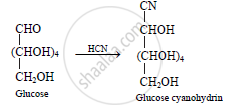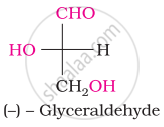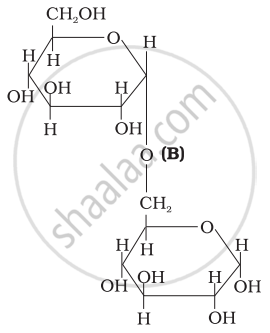Advertisements
Advertisements
प्रश्न
What happens when glucose is treated with hydrogen cyanide?
उत्तर
Action of hydrogen cyanide (HCN) on glucose: The reaction of glucose with
hydrogen cyanide gives cyanohydrin. This indicates the presence of carbonyl group.

APPEARS IN
संबंधित प्रश्न
Write the reaction that indicates the presence of -CHO group in glucose
Draw the simple Fisher projection formulae of D - (+) - glucose and D - (-) - fructose
Enumerate the reactions of D-glucose which cannot be explained by its open chain structure.
What happens when glucose is treated with hydroxylamine?
Write the product when D-glucose reacts with conc. HNO3.
Glucose on reaction with HI gives n-hexane. What does it suggest about the structure of glucose?
Differentiable between the following:
Amylose and Amylopectin
What do you observe when glucose solution is heated with Tollen’s reagent?
Answer the following question.
What is the basic structural difference between glucose and fructose?
Write the reactions involved when D-glucose is treated with the following reagent:
H2N-OH
The spatial arrangement of the given molecule is denoted by:

Choose the appropriate answer(s) for the below representation from the options given


Glucose does not react with ____________.
Which of the following properties of glucose cannot be explained by its open chain structure?
(i) Glucose does not form hydrogen sulphite with NaHSO3.
(ii) On oxidation with HNO3 glucose gives saccharic acid.
(iii) Glucose is found to exist in two different crystalline forms which are named as α and β.
Choose the correct relationship for glucose and fructose:
The number of chiral carbons in ß-D(+) glucose is ____________.
Which one is correct?
In the following reaction, identify A and B:
\[\begin{array}{cc}
\ce{C6H12O6 ->[Acetic anhydride] A}\\
\downarrow \text{Conc. nitric acid}\phantom{...}\\
\ce{B}\phantom{.................}\end{array}\]
Which of the following pairs represents anomers?
Three structures are given below in which two glucose units are linked. Which of these linkages between glucose units are between C1 and C4 and which linkages are between C1 and C6?
| (I) |  |
| (II) |  |
| (III) |  |
Assertion: D (+) – Glucose is dextrorotatory in nature.
Reason: ‘D’ represents its dextrorotatory nature.
Write the reactions of D-glucose which can’t be explained by its open-chain structure. How can cyclic structure of glucose explain these reactions?
On the basis of which evidences D-glucose was assigned the following structure?
\[\begin{array}{cc}
\ce{CHO}\\
|\phantom{....}\\
\phantom{..}\ce{(CHOH)4}\\
|\phantom{....}\\
\phantom{..}\ce{CH2OH}
\end{array}\]
What happens when D-glucose is treated with the following reagent?
HI
The number of asymmetric carbon atoms in the glucose molecule in open and cyclic form is ______.
